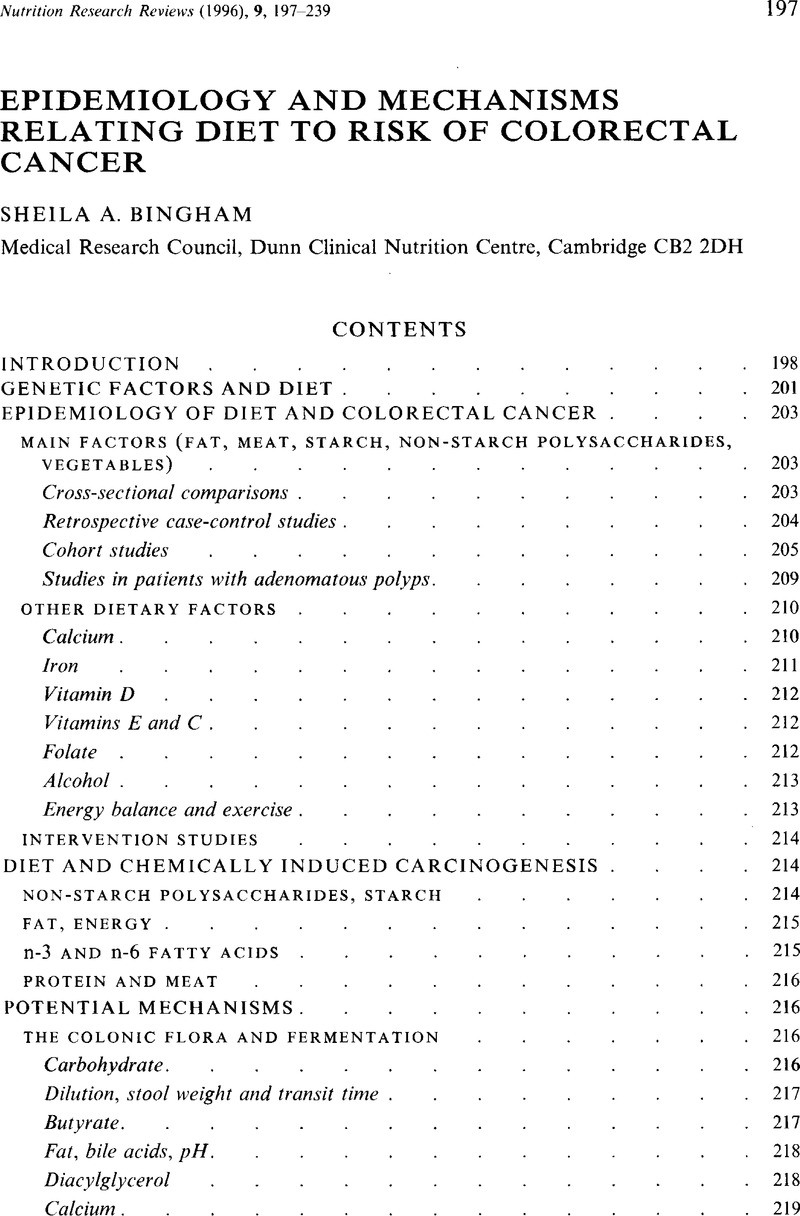Crossref Citations
This article has been cited by the following publications. This list is generated based on data provided by Crossref.
Bingham, S. A.
Atkinson, C.
Liggins, J.
Bluck, L.
and
Coward, A.
1998.
Phyto-oestrogens: where are we now?.
British Journal of Nutrition,
Vol. 79,
Issue. 5,
p.
393.
Williamson, Sophia L.H.
Kartheuser, Alex
Coaker, Julie
Kooshkghazi, Mahshid Dehghan
Fodde, Riccardo
Burn, John
and
Mathers, John C.
1999.
Intestinal tumorigenesis in the Apc1638N mouse treated with aspirin and resistant starch for up to 5 months.
Carcinogenesis,
Vol. 20,
Issue. 5,
p.
805.
Gee, Jennifer M.
Watson, Mark
Matthew, Jennifer A.
Rhodes, Michael
Speakman, Christopher J.M.
Stebbings, William S.L.
and
Johnson, Ian T.
1999.
Consumption of Fish Oil Leads to Prompt Incorporation of Eicosapentaenoic Acid into Colonic Mucosa of Patients Prior to Surgery for Colorectal Cancer, But Has No Detectable Effect on Epithelial Cytokinetics.
The Journal of Nutrition,
Vol. 129,
Issue. 10,
p.
1862.
Steer, Toni
Carpenter, Hollie
Tuohy, Kieran
and
Gibson, Glenn R.
2000.
Perspectives on the role of the human gut microbiota and its modulation by pro- and prebiotics.
Nutrition Research Reviews,
Vol. 13,
Issue. 2,
p.
229.
Johnson, I.T.
2000.
Functional Foods.
p.
141.
Wisker, Elisabeth
Daniel, Martina
Rave, Gerhard
and
Feldheim, Walter
2000.
Short-chain fatty acids producedin vitrofrom fibre residues obtained from mixed diets containing different breads and in human faeces during the ingestion of the diets.
British Journal of Nutrition,
Vol. 84,
Issue. 1,
p.
31.
Branca, F.
Hanley, A. B.
Pool-Zobel, B
and
Verhagen, H.
2001.
Biomarkers in disease and health.
British Journal of Nutrition,
Vol. 86,
Issue. S1,
p.
S55.
Higgs, J.
and
Mulvihill, B.
2002.
Meat Processing.
p.
64.
Brouns, Fred
Kettlitz, Bernd
and
Arrigoni, Eva
2002.
Resistant starch and “the butyrate revolution”.
Trends in Food Science & Technology,
Vol. 13,
Issue. 8,
p.
251.
Steer, Toni E.
and
Gibson, Glenn R.
2002.
The microbiology of phytic acid metabolism by gut bacteria and relevance for bowel cancer.
International Journal of Food Science & Technology,
Vol. 37,
Issue. 7,
p.
783.
Higgs, J.D.
and
Mulvihill, B.
2002.
The Nutrition Handbook for Food Processors.
p.
209.
Glei, Michael
Latunde-Dada, Gladys O.
Klinder, Annett
Becker, Thomas W.
Hermann, Uta
Voigt, Klaus
and
Pool-Zobel, Beatrice L.
2002.
Iron-overload induces oxidative DNA damage in the human colon carcinoma cell line HT29 clone 19A.
Mutation Research/Genetic Toxicology and Environmental Mutagenesis,
Vol. 519,
Issue. 1-2,
p.
151.
Rowland, Ian
and
Heavey, Patricia
2003.
Reviews in Food and Nutrition Toxicity.
Vol. 20031116,
Issue. ,
p.
305.
Johnson, Ian T
2003.
Functional foods and bowel cancer.
Food Science <html_ent glyph="@amp;" ascii="&"/> Technology Bulletin: Functional Foods,
Vol. 1,
Issue. 3,
p.
1.
Heavey, Patricia M.
McKenna, Declan
and
Rowland, Ian R.
2004.
Colorectal Cancer and the Relationship Between Genes and the Environment.
Nutrition and Cancer,
Vol. 48,
Issue. 2,
p.
124.
Vulevic, Jelena
McCartney, Anne L.
Gee, Jennifer M.
Johnson, Ian T.
and
Gibson, Glenn R.
2004.
Microbial Species Involved in Production of 1,2-
sn
-Diacylglycerol and Effects of Phosphatidylcholine on Human Fecal Microbiota
.
Applied and Environmental Microbiology,
Vol. 70,
Issue. 9,
p.
5659.
Pool-Zobel, Beatrice
Veeriah, Selvaraju
and
Böhmer, Frank-D.
2005.
Modulation of xenobiotic metabolising enzymes by anticarcinogens—focus on glutathione S-transferases and their role as targets of dietary chemoprevention in colorectal carcinogenesis.
Mutation Research/Fundamental and Molecular Mechanisms of Mutagenesis,
Vol. 591,
Issue. 1-2,
p.
74.
Knöbel, Y.
Glei, M.
Osswald, K.
and
Pool-Zobel, B.L.
2006.
Ferric iron increases ROS formation, modulates cell growth and enhances genotoxic damage by 4-hydroxynonenal in human colon tumor cells.
Toxicology in Vitro,
Vol. 20,
Issue. 6,
p.
793.
Knöbel, Y.
Weise, A.
Glei, M.
Sendt, W.
Claussen, U.
and
Pool-Zobel, B.L.
2007.
Ferric iron is genotoxic in non-transformed and preneoplastic human colon cells.
Food and Chemical Toxicology,
Vol. 45,
Issue. 5,
p.
804.
Sauer, Julia
Richter, Konrad Klaus
and
Pool-Zobel, Beatrice Louise
2007.
Physiological concentrations of butyrate favorably modulate genes of oxidative and metabolic stress in primary human colon cells.
The Journal of Nutritional Biochemistry,
Vol. 18,
Issue. 11,
p.
736.





